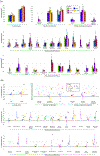Resource profile and user guide of the Polygenic Index Repository
- PMID: 34140656
- PMCID: PMC8678380
- DOI: 10.1038/s41562-021-01119-3
Resource profile and user guide of the Polygenic Index Repository
Abstract
Polygenic indexes (PGIs) are DNA-based predictors. Their value for research in many scientific disciplines is growing rapidly. As a resource for researchers, we used a consistent methodology to construct PGIs for 47 phenotypes in 11 datasets. To maximize the PGIs' prediction accuracies, we constructed them using genome-wide association studies-some not previously published-from multiple data sources, including 23andMe and UK Biobank. We present a theoretical framework to help interpret analyses involving PGIs. A key insight is that a PGI can be understood as an unbiased but noisy measure of a latent variable we call the 'additive SNP factor'. Regressions in which the true regressor is this factor but the PGI is used as its proxy therefore suffer from errors-in-variables bias. We derive an estimator that corrects for the bias, illustrate the correction, and make a Python tool for implementing it publicly available.
© 2021. The Author(s), under exclusive licence to Springer Nature Limited.
Conflict of interest statement
Competing interests
D.A.H., A.K., and members of the 23andMe Research Team are current or former employees of 23andMe, Inc. and hold stock or stock options in 23andMe. The authors declare no other competing interests.
Figures



References
Publication types
MeSH terms
Grants and funding
- K99 AG062787/AG/NIA NIH HHS/United States
- R24 AG065184/AG/NIA NIH HHS/United States
- MC_QA137853/MRC_/Medical Research Council/United Kingdom
- P2C HD042849/HD/NICHD NIH HHS/United States
- R01 HD083613/HD/NICHD NIH HHS/United States
- MR/P005918/1/MRC_/Medical Research Council/United Kingdom
- U01 MH109539/MH/NIMH NIH HHS/United States
- R01 AG042568/AG/NIA NIH HHS/United States
- R56 AG058726/AG/NIA NIH HHS/United States
- R01 HD092548/HD/NICHD NIH HHS/United States
- G1002190/MRC_/Medical Research Council/United Kingdom
- R00 AG062787/AG/NIA NIH HHS/United States
- MC_PC_17228/MRC_/Medical Research Council/United Kingdom
- R01 MH101244/MH/NIMH NIH HHS/United States
LinkOut - more resources
Full Text Sources
Other Literature Sources
Research Materials
Miscellaneous

